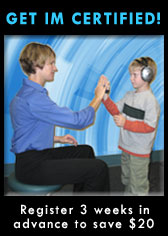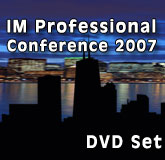A: There is some buzz out
there about engaging in certain activities
to delay the progression of Alzheimers. IM
has not been studied in this population and
we are not aware of anyone using it for this
purpose. If you are interested in pursuing
the "Affects of IM on early Dementia", we would be interested to know the
results. IM pays or provides free IM hours
for case studies that are submitted and
accepted.
Age
Q:
What is the youngest age IM can be used
with?
A:
It was previously thought that patients had
to be at least 6 because this was the age at
which the child could comprehend and use the
guide sounds. Since then, we’ve learned
that younger patients make tremendous gains
even when total hands-on assistance is
provided the entire time and the guide
sounds are off. Recently, an SLP in Georgia
presented nationally on an 18 month old infant.
She is using IM with a child diagnosed with agenesis
of the corpus collosum who was not making
much gain with traditional OT, PT, and
Speech therapies. This patient could not be
kissed, held, bathed, caressed, fed, the
baby did not make eye contact, babble or
crawl. After 4 months of IM in the home
3x/week with total hands-on assist, the
child can sit in the provider’s lap, be
caressed, kissed, eats solid foods, actively
seeks and makes eye contact, is beginning to
babble, and crawls.
Athletes
Q:
Do any pro athletes use IM?
A:
Yes. Many do. We cannot share all of their
names because IM does not have an
endorsement relationship with them. Some
players/teams that the media has reported using
IM are:
-
PGA - Vijay Singh, Glen Day
-
NBA – Miami Heat
-
NFL – Miami Dolphins
-
NHL-
Florida Panthers
-
Universities – Notre Dame,
Syracuse, North Carolina, Miami
C
Calibration
Q:
How do you recalibrate the IM?
A:
The IM is engineered to recalibrate each
time the USB is connected to the computer
and the computer is powered up. It is
important to shut down your IM computer at
the end of each day and disconnect the USB
cord. Other details of calibration are
patent-protected.
Case Study
Q:
How do I submit a case study?
A: Visit the IM
website
www.interactivemetronome.com and click
on the Provider Login.
Charging for IM
Q: What are providers are
charging in their region?
A: Charges for IM vary
depending upon region and profession. Charges
IM typically mirror usual and customary
charges for the provider's other services.
Clinical & Technical support
Q: Who should I contact for
clinical or technical support once get IM?
A: Call IM @
877-994-6776 Option 4 Technical Support,
Option 7 Clinical Support
Colleges & Universities
Q: Are there any
colleges & universities that use IM in their
academic training programs?
A: Yes. Several for
PT, OT, SLP, and MD training programs.
Contact IM
Clinical Education Director for
additional info if desired.
D
Dance Dance Revolution (DDR)
Q: How is IM different
from Dance Dance Revolution (DDR)?
A: The pace of the IM program
can be adjusted to suit individual needs
and this is not the case with DDR. IM provides a
sequential, logical learning hierarchy and
critical feedback for timing, DDR does not.
IM tasks can be adapted for impaired motor
skills, DDR cannot. IM can be done via
auditory or visual channel alone, DDR cannot.
IM is beat is rhythmic and predictable which
is critical to motor planning, DDR is not.
We still think DDR is a fin game though!
Deaf
Q: Can IM be used with
a deaf person?
A: Yes, by using the
visual mode with center flash. The center flash
serves as the stimulus for the metronome and
visual guides help the patient get better with
timing.
Depression
Q: Has IM been shown
to have any effect on depression?
A: We’ve received a
couple of anecdotal reports from IM
providers on this application who report
good outcomes, nothing substantiated or
studied at this time.
Dr. Greenspan
Q: What is Dr.
Greenspan’s involvement with IM?
A:
Dr. Greenspan remains the Chairman of IM's
Scientific Advisory Board.
Dr. McGrew
Q: Dr. McGrew’s
relationship to IM?
A:
Dr. McGrew
is a member of
IM's Scientific Advisory Board. He reviews research
proposals and provides input regarding statistical
analysis. He also provides updates on temporal
processing research.
Durability of IM Outcomes
Q: Are the outcomes
from IM long-lasting, or does a patient need
to repeat IM at certain intervals to
maintain gains?
A: Anecdotally, gains
appear to stick in most cases. Patients
tested more than a year after having IM
treatment continue to demonstrate the
improved ms scores (typically within 10 ms
of discharge scores) and continue to
demonstrate functional gains. Many continue
to improve upon gains made and are doing
even better.
There have been some reports
of a few patients that needed to take a few
booster sessions to get back to peak
performance after a period of months
without IM intervention. It is unclear why
it sticks for most and not for a few. For
the few that need booster sessions, it is
reported they only need a few sessions to
get back to peak performance (not requiring
as much as they did the first time).
It is important to consider
the concept of ‘learned helplessness’ and
how this may impact generalization and
maintenance of gains. It is important for
therapists and family members to encourage
use of new skills once IM treatment is
concluded.
Look for more FAQs
of the
alphabet in the March eNews




